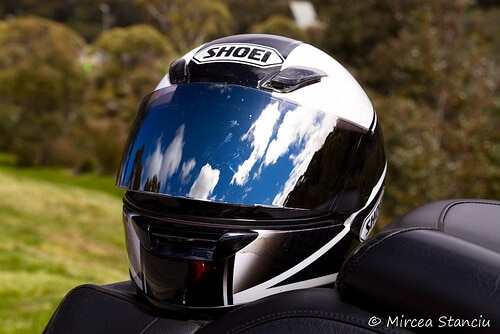
Riding a motorcycle can be a dangerous way to get around. In more than half of crashes involving a motorcycle and a vehicle, the rider is not at fault. But lack of blame doesn’t make crashes less hazardous for motorcyclists: 75 percent of crashes result in an injury or fatality for the rider.
One of the best things you can do to reduce your risk of serious injury or death on your motorcycle is to wear a sturdy helmet. If you crash, a DOT-compliant helmet can help minimize head trauma, possibly saving your life. A National Highway Traffic Safety Administration study found that motorcyclists wearing helmets had a lower likelihood of injuries to the head and face in a crash, and they were less likely to suffer a traumatic brain injury.
In Maryland, helmets aren’t just a suggestion for motorcycle riders; they’re the law.
Under Maryland state law, all drivers and passengers of motorcycles must wear helmets meeting the state Motor Vehicle Administration’s requirements. The administration uses Federal Motor Vehicle Safety Standard 218 as its minimum standard for compliant helmets.
The easiest way to ensure that your helmet is compliant with state law is to use one with a factory-applied label of “Department of Transportation” or “Snell Memorial Foundation.” Some helmets bear both labels. When the helmet doesn’t include the factory-printed DOT label, it should include a label that’s sewn inside showing the month and year the helmet was made.
In addition, motorcycle operators must wear approved eye-protection devices if their bikes are not equipped with windscreens. Any goggles, prescription lenses or face shields you use while riding must comply with impact-resistance regulations from the Food and Drug Administration. At times that motor vehicles must use their lights, you’re required to use clear, non-tinted eye protection.
Motorcycle windscreens are required to be fastened securely to the bike. If you choose not to wear an approved device for eye protection, your windscreen must be attached at a height that’s appropriate to protect your eyes and face while you’re sitting on your bike in a typical position for riding. It’s recommended that you wear protective eye gear even if your bike has an appropriately installed windscreen.
Helmets don’t prevent crashes, but they do help protect you in a crash. If you take a blow in a crash, your approved helmet will provide some protection to your head and brain by dispersing the huge amount of force that occurs. Helmets have four basic parts that work together to protect you:
If your helmet doesn’t fit properly, it may not do its job when you need it most. It also may feel uncomfortable as you’re riding. Try on a variety of helmets from different manufacturers, and get one that fits snugly but not tightly. For your safety and comfort, don’t buy a used helmet.
Maryland’s Motorcycle Safety Program also recommends that you invest in some additional protective gear designed specifically for motorcyclists. Appropriate gear will help you stay comfortable in a variety of weather conditions, and it will help keep you safe. Gear to consider includes:
Accidents between motorcycles and cars can result in serious injuries and even death. If you’ve been injured in a crash, or if a loved one has been killed, it’s vital that you work with experienced motorcycle accident attorneys to ensure that your rights are protected and you receive fair compensation. To speak with an attorney, please contact DuBoff & Associates, Chartered.
More Information
Filed Under:
Comments are closed.